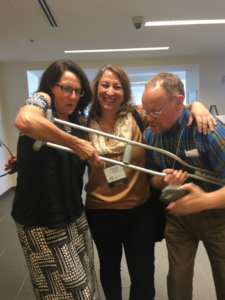By Nedra Chandler
This post originally appeared on Cadence blog February 28, 2018. We are reposting it with Nedra Chandler’s permission.
 Humans can be Bermuda Triangles of needs.
Humans can be Bermuda Triangles of needs.
If you are a leader, team participant, or facilitator of collaborative work of any kind, I promise you at least one insight you can use and apply directly to what you do. Here are 3 points of the triangle representing human needs for 3 different kinds of satisfaction.
Maybe you work with a team or an inter-agency or other multiparty group. Do you remember the last meeting you were part of that ran off the rails, either a little or a lot? You might have left thinking: “why?”
Why do we seem to make things so hard? Why is this situation such a mess? Why can’t we pick a direction and go? Why does everything take so long? Why? Why? Why?
Enter the Triangle of Satisfaction – one of most powerful, “sticky” (as in it sticks with you) pieces of applied theory ever, especially in the realm of public decision-making, yet also in the world of leaders and teams — how we humans rock and roll.

The diagram shows the three types of satisfaction we all need every time we seek agreement, movement or improvement on complex issues, plans or decisions: substantive, procedural, and emotional/relational.
This may be especially relevant for public work and decisions by government agencies and/or elected officials.
All participants harbor these intersecting needs, whether conscious of them or not. We humans not only want, but need, these types of satisfaction in order to reach decisions and move forward.
Let’s take each type of need in turn and see how you might apply these. Click on the Rolling Stone’s tune, Can’t Get No Satisfaction for background music to enhance your experience of this post here.
SUBSTANTIVE Satisfaction
The substance is simply the thing you are doing or deciding. It is often the easiest to identify. But ask yourself: “is what we’ve defined as the substance just the tip of the iceberg”?
What is submerged below the surface that could hinder collective progress? The answer is in the other two corners of the triangle, the ones that are below the surface. P.S. the ones you can’t see. The ones just waiting to crash the boat into.
Get notified when new articles are posted to the EDR blog – sign up for our email list »
A famous example of this was during the Vietnam War peace negotiations where participants spent months haggling over the shape of the table and who would sit where.

Submerged needs for clear Process and Relational Satisfaction will greatly affect any purposeful dialog or discussion. Every time.
The ability to step back and deliberately design a tailored process and with relational/emotional safety in it rather than rushing and driving straight to possible ‘solutions’ is key. It’s also a primary value a facilitator, or facilitative leadership team can bring in with, for example, the use of readiness assessments, liberating microstructures or mutual gains negotiations.
Challenge for fun on substance tip of triangle: think of a time you were part of group that faced conflict over substantive issues. What was it about? And how did things show up on the surface? Just recall that first. Then get ready to consider how questions of process and emotion shaped what happened next.
PROCEDURAL Satisfaction
In complex settings, procedural satisfaction is way too routinely overlooked.
Participants and others with a stake in the outcomes must use or create credible processes by which people can catalog together what the facts are, consider what they mean, and then discern now what can happen next.
What process will be followed? Who will decide? What steps will be taken and how long will it take? Is the process fair and transparent? Is it inclusive? Why or why not? Who will interact with whom at what points in the work?
Think of the many times you’ve been in any role with this scenario. The data may be there to support a decision, but if participants, the partnering agencies and/or people with a stake in the outcomes don’t find some honest ways to come along, then…can it be supported and carried out? Hmmmmm.
Challenge for fun on process tip of triangle: thinking of that situation you recalled from your own experience, what were the steps you took to collaboratively frame and explore the issues at hand? Were they more or less sequential steps? Was there a realistic time line or not? By what means did people stay oriented to the process? See my friend Martha Bean’s visual “framing” here.
EMOTIONAL Satisfaction
No big surprise here: people need emotional satisfaction.
What’s happening here: ask “how do you/they feel about the whole shebang?” Specifically, is there sufficient mutual trust or at least a working trust and respect present? If not, how will we make this a safe enough space to engage anyway?
People with the biggest stake in the outcomes often (and need to!) consider their other best alternatives to collaboration — other methods for getting their interests met at any point in the work. Depending on the context, ethics, and existing relationships, there’s nothing wrong with any of these strategies to get interests met.
Think for example of some of these potentially best, or better, alternatives to collaboration:
-litigation
-other ways to block or discredit decisions.
-media or other campaigns
-civil disobedience
-other?
Checking on the emotional state of the situation is a must for anyone charting a path forward in a contentious environment.
Challenge for fun reflecting on the emotional tip of the triangle: now think about someone in the situation you recalled from your own experience. This could be you or someone else: what qualities did this person bring to the situation that helped or otherwise memorably affected how people felt in the situation? What upfront or other shared expectations allowed for progress with emotional satisfaction?
(note: sometimes people use the words “relational” or “psychological” satisfaction for this ‘emotion’ corner of the triangle.)
Collaborative Work Requires Attention, and Usually More Time Than You Expect…
Want outcomes that can be carried out over the long haul? Want decisions that people will not only support but also tell a story later with liveliness and satisfaction? Want to, as Keith McCandless says, “unleash and include everyone” and make room for innovation?
A situation is always ripe for something by way of increasing substantive, procedural and emotional success and satisfaction. The questions are mostly ready for what? With whom and how?
Stay curious while looking and paying close attention both above and below the surface to all three aspects of the Triangle of Satisfaction.
Cherie Shanteau-Wheeler and I had just spent a wonderful year teaching and coaching facilitation and collaboration skills to and with public land managers in 2015 when I wrote this the first time. Each time in our courses and onsite work, it was an all-time favorite to bring out this Triangle of Satisfaction and then hear participants say, “I get it! I’ll use that!”
Maybe you already apply this. Maybe you are a pioneer in this field of ours who helped embellish this piece of theory. I hope you find it valuable and simple. It’s simple, but not always easy. In my own work I find it useable nearly every day.
(Special note: we all stand on one another’s shoulders: this Triangle of Satisfaction comes from the work of Chris Moore from CDR as one original source of this model as well Julia Gold of the University of Washington Law School for the ‘tip of the iceberg’ metaphor, and also Rhian Williams and the South Australian Aboriginal Legal Rights Movement for some of the insights as well. Thanks!)
 Nedra Chandler: A bit about me — external coach and process maven. My latest jam is about organizational health and development, preventing & managing conflict and delivering credentialed coaching for government leaders and teams. In my current blog series I am offering my readers practical moves to give ourselves and each other permission to keep learning. Thanks for reading and sharing with folks who may find it useful.
Nedra Chandler: A bit about me — external coach and process maven. My latest jam is about organizational health and development, preventing & managing conflict and delivering credentialed coaching for government leaders and teams. In my current blog series I am offering my readers practical moves to give ourselves and each other permission to keep learning. Thanks for reading and sharing with folks who may find it useful.
We help people listen and talk with each other with purpose and clarity. We find out what people are ready for and design custom opportunities to find common ground and to take action. Find me and my long-time work mates at Triangle Associates and please sign up to receive my monthly posts in your inbox by typing in your email address here.
